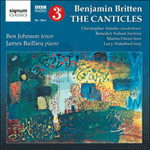
Welcome to Hyperion Records, an independent British classical label devoted to presenting high-quality recordings of music of all styles and from all periods from the twelfth century to the twenty-first.
Hyperion offers both CDs, and downloads in a number of formats. The site is also available in several languages.
Please use the dropdown buttons to set your preferred options, or use the checkbox to accept the defaults.

| Ben Johnson (tenor), James Baillieu (piano), Martin Owen (horn)» More |
As the original poem is quite irregular in metre, a lyrical setting would have been inappropriate, so the text is declaimed in the form of recitatives, culminating in a type of sprechgesang at the climactic moment where the poet quotes a phrase from the end of Christopher Marlowe’s play Doctor Faustus. Between these recitatives, the horn and piano play interludes consisting of a theme and six variations, based on an atonal series of ten notes, whose intervals alternately expand and contract, the final variation serving as a coda. This technique is closely related to the opera The Turn of the Screw, which Britten had recently completed.
from notes by Michael Short © 1992
Le poème original étant en vers assez irréguliers, un arrangement lyrique aurait été inapproprié, et le texte est déclamé sous forme de récitatifs, atteignant une apogée avec une sorte de «sprechgesang» au moment où la poétesse cite une phrase de la fin de la pièce de Christopher Marlowe, Doctor Faustus. Le cor et le piano jouent entre ces récitatifs des interludes consistant en un thème et six variations, basés sur une série atonale de dix notes, dont les intervalles augmentent et diminuent alternativement, la dernière variation servant de coda. Cette technique est étroitement associée à l’opéra The Turn of the Screw, que Britten venait de terminer.
extrait des notes rédigées par Michael Short © 1992
Français: Elisabeth Rhodes
Da die Gedichtvorlage vom Metrum her sehr unregelmäßig ist, wäre eine lyrische Vertonung unangebracht gewesen. Darum wird der Text in Form von Rezitativen deklamiert, die im entscheidenden Moment, wenn die Dichterin einen Satz aus dem Schlußteil von Christopher Marlowes Schauspiel Doctor Faustus zitiert, in einer Art Sprechgesang gipfelt. Zwischen diesen Rezitativen geben Horn und Klavier Zwischenspiele in Gestalt eines Themas mit sechs Variationen auf der Basis einer atonalen Folge von zehn Noten, deren Intervalle sich abwechselnd vergrößern und verkleinern, wobei die letzte Variation als Coda dient. Dieses Verfahren ist eng verwandt mit dem der Oper The Turn of the Screw, die Britten kurz zuvor vollendet hatte.
aus dem Begleittext von Michael Short © 1992
Deutsch: Anne Steeb/Bernd Müller
 Britten: The Canticles Britten: The Canticles'The supporting performers are well chosen. Abraham and lsaac opens with Johnson and countertenor Christopher Ainslie, judiciously placed by th ... 'One of the more interesting of the tide of Britten centenary tributes, The Canticles features the five vocal settings composed at various poin ...» More |

